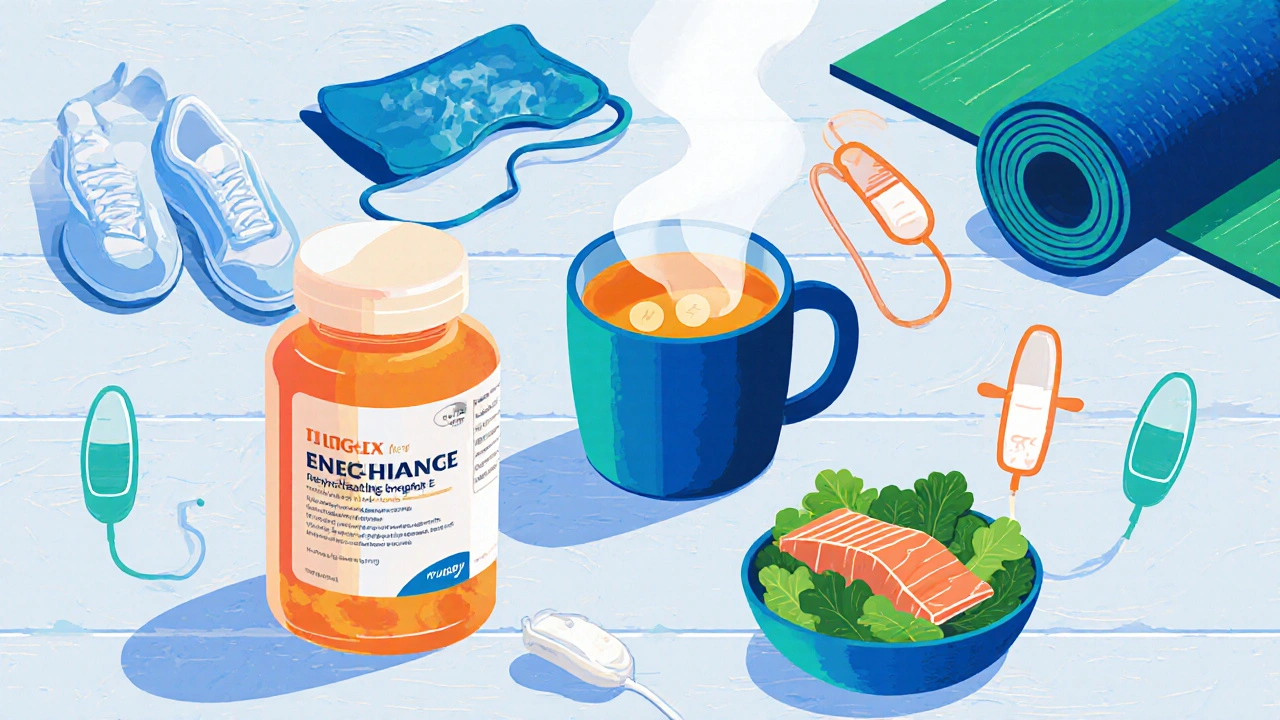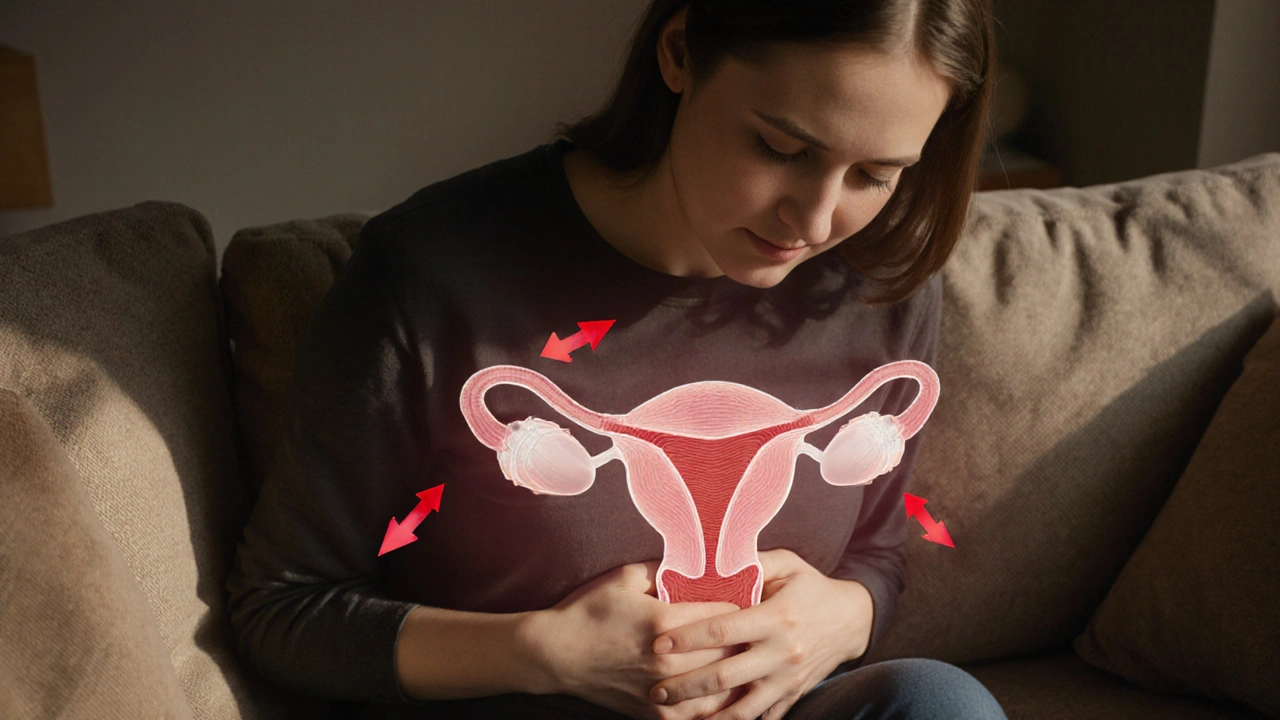Menstrual Cramp Severity Checker
Your Symptom Assessment
Click "Check My Symptoms" to assess your menstrual cramp severity and receive personalized recommendations.
If you’re fed up with the sharp, throbbing menstrual cramps that ruin your day, you’re not alone. Around half of people who menstruate experience painful periods, and many wonder why the pain hits hard and how to stop it. This guide breaks down the biology, the warning signs, and the best ways to find relief - whether you prefer a pill, a hot pack, or a lifestyle tweak.
Key Takeaways
- Menstrual cramps, medically called dysmenorrhea painful uterine contractions that occur before or during menstruation, are triggered by hormonal compounds called prostaglandins.
- Typical symptoms include throbbing lower‑abdominal pain, backache, nausea, and headache; severe pain may signal an underlying condition.
- First‑line treatments are non‑steroidal anti‑inflammatory drugs (NSAIDs) and heat therapy; hormonal birth control can prevent pain at the source.
- Natural remedies-exercise, dietary tweaks, and herbal supplements-work for many, but consistency matters.
- Seek medical advice if pain disrupts daily life, lasts longer than a few days, or is accompanied by heavy bleeding or fever.
What Are Menstrual Cramps?
In plain language, menstrual cramps are painful muscle‑like contractions of the uterus that help shed its lining. When the lining breaks down, the uterus tightens to push the tissue out, and the intensity of those squeezes creates the ache we feel.
The medical term for this condition is dysmenorrhea painful menstrual periods caused by uterine contractions. Dysmenorrhea comes in two flavors: primary (no underlying disease) and secondary (linked to conditions such as endometriosis or pelvic inflammatory disease).
Why Do They Happen? Common Causes
The chief driver of cramps is a group of hormone‑like substances called prostaglandins lipid compounds that trigger uterine muscle contractions. Higher prostaglandin levels mean stronger, more frequent squeezes, which translates to sharper pain.
Other factors that can amplify the effect include:
- Low magnesium or vitaminB6 levels, which may affect muscle relaxation.
- High stress, which raises cortisol and can heighten pain perception.
- Structural issues like fibroids or a tilted uterus.
When cramps are linked to an underlying condition, they’re classified as secondary dysmenorrhea. Two common culprits are:
- Endometriosis tissue similar to the uterine lining growing outside the uterus, which creates inflammatory lesions that contract with each period.
- Pelvic inflammatory disease (PID) infection of the female reproductive organs that can cause chronic pain, often tied to sexually transmitted infections.

Spotting the Symptoms
Typical menstrual‑cramp symptoms start 1‑2days before bleeding and may last up to three days. Look for:
- Throbbing or cramping pain in the lower abdomen.
- Radiating pain to the lower back or thighs.
- Nausea, vomiting, or diarrhea.
- Headaches or dizziness.
If you notice any of the following, it could signal secondary dysmenorrhea and deserves a doctor’s look:
- Pain that starts earlier than the period or continues long after bleeding stops.
- Heavy bleeding (soaking a pad in under an hour).
- Fever, chills, or foul‑smelling discharge.
- Pain that worsens with intercourse.
Effective Treatment Options
Choosing a treatment depends on pain severity, personal preference, and any underlying health issues. Below are the most widely recommended approaches.
1. Over‑the‑Counter Pain Relievers
NSAIDs non‑steroidal anti‑inflammatory drugs that block prostaglandin production such as ibuprofen (200mg every 4‑6hours) or naproxen are the first line because they target the root cause-prostaglandins. Take them with food to avoid stomach upset.
2. Heat Therapy
Applying heat to the lower abdomen relaxes uterine muscle fibers. A heating pad set to 40‑45°C for 15‑20minutes can cut pain scores by up to 50% according to a 2023 clinical trial. Warm baths work as well, especially when combined with gentle stretches.
3. Hormonal Birth Control
Combined oral contraceptives, the patch, or the hormonal IUD reduce the amount of uterine lining, which means fewer prostaglandins and milder cramps. For many, hormonal birth control is the only way to achieve near‑pain‑free periods.
4. Lifestyle and Natural Remedies
- Exercise: Regular aerobic activity (30minutes, 3‑5times a week) lowers prostaglandin levels and improves blood flow. Even a short brisk walk on the first day of bleeding can help.
- Diet: Foods rich in omega‑3 fatty acids (salmon, walnuts) and magnesium (leafy greens, seeds) have been shown to ease cramps.
- Herbal supplements: Ginger tea (1gram fresh ginger) and turmeric (500mg curcumin) both possess anti‑inflammatory properties.
- Acupressure: Pressing pointLI4 (between thumb and index finger) for 2minutes can reduce pain perception in some studies.
5. Prescription Options
When OTC meds fall short, doctors may prescribe stronger NSAIDs, muscle relaxants, or hormonal therapies such as GnRH agonists. These are usually short‑term due to side‑effect profiles.
Comparison of Common Treatments
| Treatment | How it works | Typical cost (UK) | Pros | Cons |
|---|---|---|---|---|
| NSAIDs (e.g., ibuprofen) | Blocks prostaglandin synthesis | £2‑£5 per pack | Fast relief, OTC | Stomach irritation, limited for heavy pain |
| Heat therapy | Relaxes uterine muscle fibers | £0‑£10 (pad or hot water bottle) | No medication needed, safe | Requires time, effect varies |
| Combined oral contraceptive | Thins uterine lining, reduces prostaglandins | £5‑£15 per month | Prevents pain, regulates cycle | Hormonal side‑effects, prescription needed |
| Exercise & diet changes | Lowers inflammation, improves circulation | Free‑£30 (gym membership) | Overall health boost | Requires consistency, gradual effect |
| Prescription NSAIDs / muscle relaxants | Stronger prostaglandin inhibition | £20‑£40 per prescription | Effective for severe pain | Potential liver/kidney impact, doctor visit |

When to See a Healthcare Professional
Most cramps improve with the strategies above, but medical evaluation is warranted if any of these red flags appear:
- Pain that disrupts work, school, or sleep for more than two days.
- Bleeding that soaks a regular pad in under an hour.
- Fever, chills, or foul‑smelling vaginal discharge.
- Sudden change in pain pattern, especially after age30.
A quick visit can rule out endometriosis, fibroids, or PID, and may open doors to targeted therapies such as laparoscopic surgery or hormonal implants.
Everyday Tips for Managing Pain
- Start a pain‑relief routine before bleeding begins; taking a low dose of ibuprofen 24hours ahead can blunt the prostaglandin surge.
- Keep a period‑tracking journal to spot patterns - note pain intensity, diet, stress levels, and any medication you use.
- Stay hydrated; dehydration can intensify muscle cramps.
- Use a cordless heating pad with adjustable settings to avoid burns.
- Practice gentle yoga poses like Child’s Pose and Cat‑Cow during the first two days of flow.
Frequently Asked Questions
Can menstrual cramps be completely eliminated?
For many, hormonal birth control or a consistent NSAID regimen can reduce pain to a barely noticeable level. However, if an underlying condition like endometriosis is present, complete elimination typically requires medical treatment.
Is it safe to take ibuprofen every month?
Occasional use during periods is considered safe for most healthy adults. If you find yourself needing it every cycle, discuss alternative options with a GP, as chronic NSAID use can affect stomach lining and kidneys.
Do diet changes really help?
Studies from 2022‑2024 show that a diet low in saturated fat and high in omega‑3s, magnesium, and vitaminB6 can lower prostaglandin levels and modestly reduce cramp intensity. The effect is gradual, so give it a few cycles to notice.
What’s the link between stress and period pain?
Stress raises cortisol, which can amplify pain perception and disrupt hormone balance, leading to higher prostaglandin release. Mind‑body practices like meditation or deep‑breathing have been shown to cut pain scores by up to 20%.
When should I consider a hormonal IUD for cramps?
If OTC meds and short‑term hormonal pills haven’t helped, a levonorgestrel IUD (e.g., Mirena) can provide continuous, low‑dose hormone release that often eliminates cramps after the first month. It’s a good option for those wanting long‑term contraception too.







Anna Österlund
October 10, 2025Don't let those cramp blues hold you back-grab a heating pad and smash the pain with a bold dose of ibuprofen before the flow even starts! You’ve got the power to own your cycle, so stack those healthy habits and watch the misery vanish. Keep that fire burning, and never settle for anything less than relief!